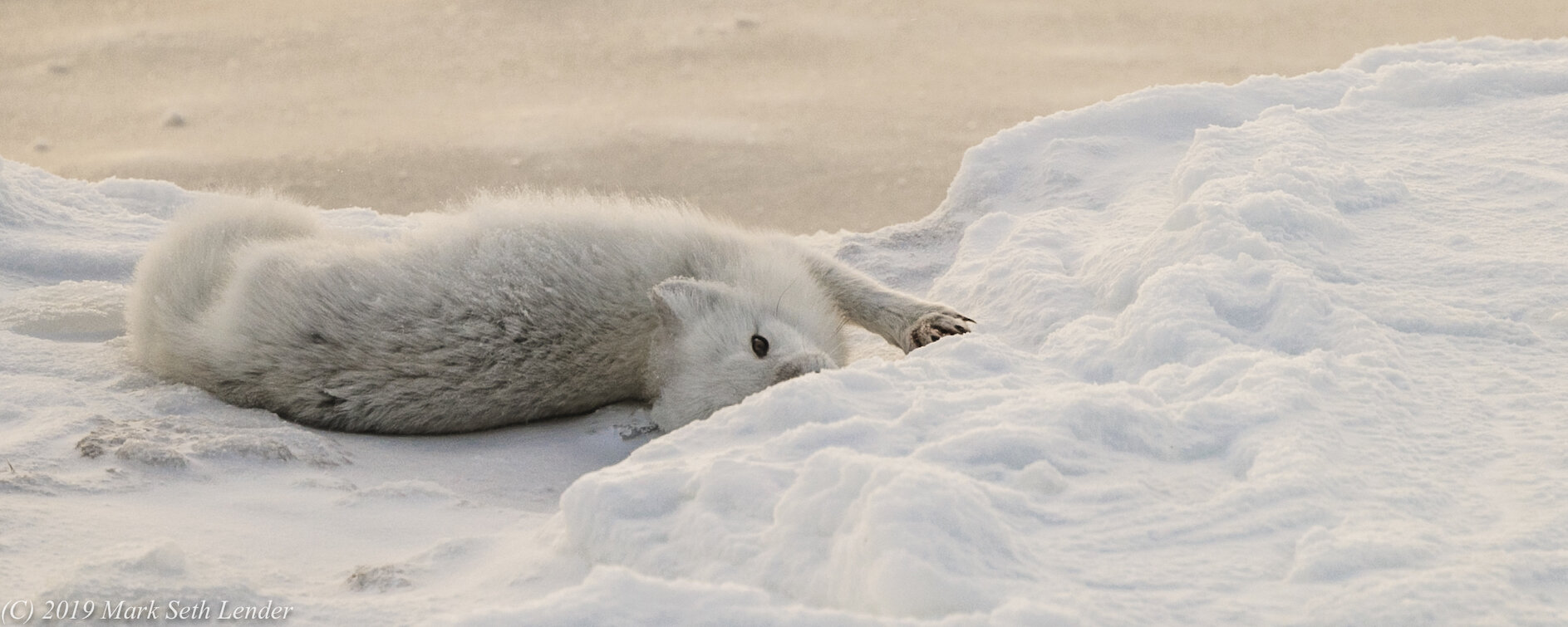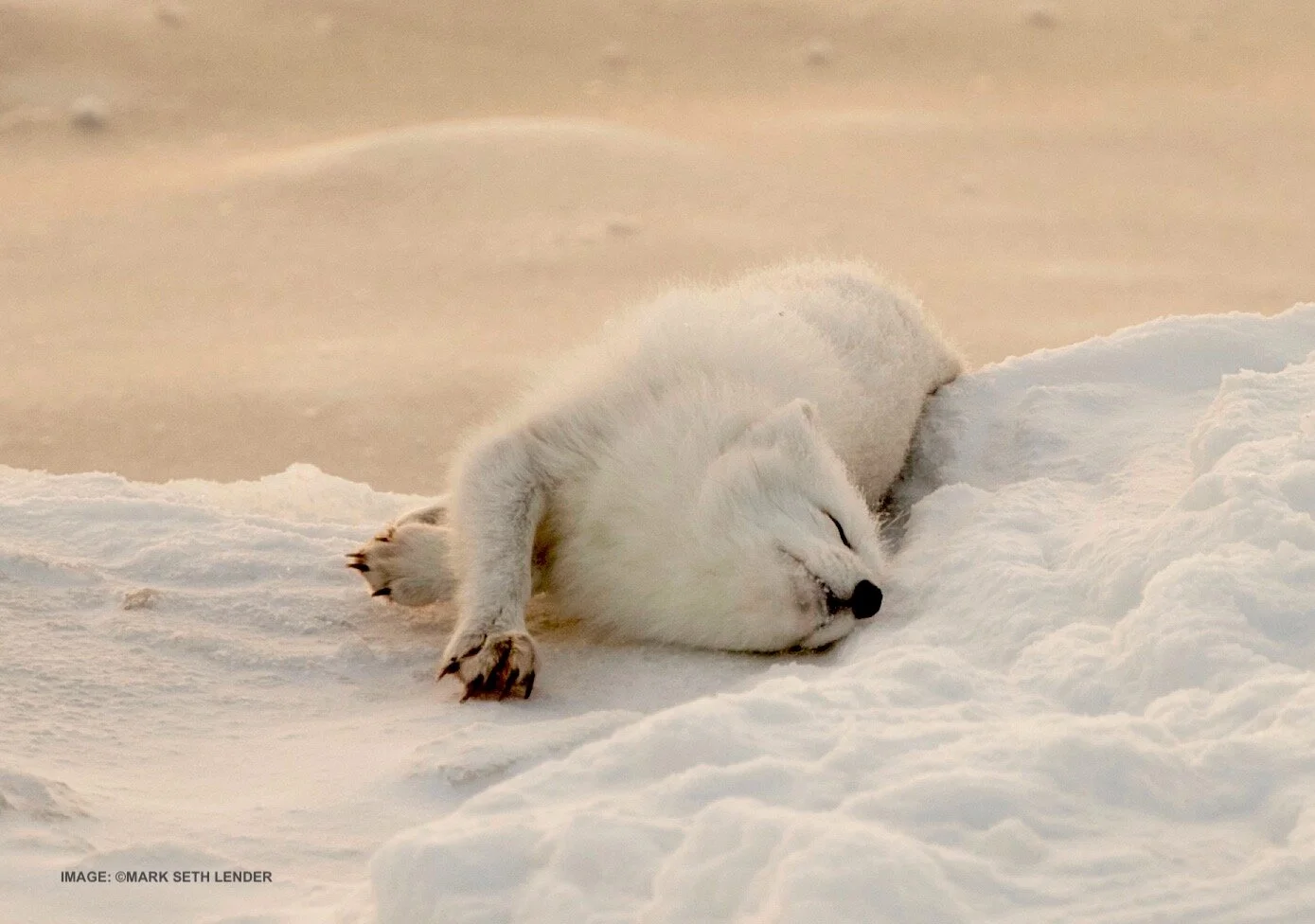Arctic Fox Hunting
Mark Seth Lender, Poet, Story teller, Living on Earth Explorer in Residence, and Destination; Wildlife Team Member.
For over forty years, twice as long as the longest life span of longest-lived predator, huge white Tundra Buggies have carried visitors over the icy tundra of the remote southwestern shores of Hudson Bay, keeping both visitors and wildlife safe. As Mark sees it, those giant buggies, the visitors they carry, have become part of the scenery. The wildlife pays them no mind.
✍︎Editor’s Note: Mark’s story-poem was originally broadcast as part of public radio’s Living on Earth series. Mark Seth Lender is a Living on Earth Explorer in Residence.
Listen as this remarkable storyteller recounts his experience, or read his words below. And don’t miss Arctic Fox Field Notes at the end.
Arctic Fox Hunting
Cold slams shut like a safe door, the snow locked down like an iron box.
Along the ridge, and through the icebound scrub, where the Arctic willow holds back its buds comes the Arctic Fox, into the clearing. He stops. He cocks his head - 2 Left 3 Right 5 Left - listening for the tumblers to click. And pounces! Face buried in the powdery stuff. And comes up, empty. Arctic vole won’t let go of her stronghold house made fast by snow and silence.
Arctic Fox changes tack, working instead by the sharp of a nose that follows the track his eyes cannot see, his ears cannot hear.
Inhaling… Exhaling…
The odors he detects both storyline and cartography; of what went this way, and that. And what hides. He prods and tests, trying to trick an unpickable lock to beat Winter’s Time Clock.
And time… is running… out.
Head down, body slinking low, Fox climbs onto the blue ice rising between boulders - suddenly trapped - by a scent too sweet to pass! His attention in its gentle grasp he rolls, onto his shoulders and stretches… his limbs, toes out spread, ears pulled back, lips teased to a foxy grin.
What does the unseen world say to Arctic Fox? What is his pleasure? What perfumes speak from the rime-crusted cold:
Sea-sweet innards of seal drizzled down the chin of polar bear?
The place where ptarmigan found sleep?
Did a pair of Arctic hare have congress here in anticipation of a distant Spring?
Did snowy owl dine on some delicious morsel, just here?
He knows, of Wonders (you and I will never uncover).
Arctic Fox stands and arches his back in what might seem a domesticated gesture reminiscent of the lapping dog, who will never be his equal in the perpetual Quest, never contribute his fluffy manicured pallor to the white-on-white only Arctic fox invests with meaning.
Exit Arctic fox? Can they adapt and survive in a changing world? Image: ©Mark Seth Lender
Mark’s Field Notes: Arctic Fox
Tundra Buggies and Protecting the Wildlife
✔︎ Trip Tips
Where: Churchill Point, Hudson Bay, Manitoba, Canada
What: Arctic Wildlife
How: Fly to Winnipeg, then onto Churchill
When: Sept.-Nov.
Contact us
Tundra Buggies are huge and white and unforgivably intrusive machines (or so I always thought). For years I wouldn’t have anything to do with them. I was wrong. No Arctic predator lives past the age of twenty, Tundra Buggies have been prowling Churchill Point twice that long. No animal alive has known a time when they did not exist as a permanent and predictable part of the landscape. They never stray off road and above all no one aboard shoots the wildlife other than with a camera. In a Tundra Buggy you are well and duly ignored and free to observe at close proximity.
Arctic Fox looked straight at me, more than once, and in some way as in any interaction this must have altered his behavior, if only as a pause in routine. That his hunt was not successful is another matter. I did not see him catch a single thing. He should have.
A New Threat to Arctic Fox’s Survival, Silver Fox Moving North
There were silver foxes in the area, and I also saw them hunting, with evident and repeated success. A clear intrusion on the range of Arctic foxes especially in November. The larger problem lay in what at least one silver fox was hunting besides voles: Arctic foxes.
A few days before I arrived a silver fox had been observed killing and eating an Arctic fox kit. The day after I left an adult Arctic fox was killed and eaten. This individual was not the one described here but another I had photographed. She had a vertical scar that ran from the ridge of the eyebrow to below the eye socket and while the eye itself looked to be intact, maybe it wasn’t. She was relatively thin, an indicator of sexual dimorphism or age perhaps, or hunting skill. An adult silver fox is bigger and stronger than any Arctic fox, thin or fat.
Arctic foxes cannot go further north where in winter they could not survive. And they cannot stay.
Living on Earth is an independent media program and relies entirely on contributions from listeners and institutions supporting public service. Please donate now to preserve an independent environmental voice.
Contribute to Living on Earth and receive, as our gift to you, an archival print of one of Mark Seth Lender's extraordinary wildlife photographs. Follow the link to see Mark's current collection of photographs.
Buy a signed copy of Mark Seth Lender's book Smeagull the Seagull & support Living on Earth
Mark Seth Lender’s stay in Churchill was hosted by Frontiers North, the inventors of the Tundra Buggy, www.FrontiersNorth.com. Mark’s fieldwork and travel are arranged by Destination: Wildlife. Contact us for information
Interested in visiting Churchill Point? Contact Us
FOLLOW US
MORE
Time Out in the Antarctic with Crabeater Seals
By Mark Seth Lender
Love in the Antarctic, Homemaking with Gentoo Penguins
By Mark Seth Lender
9 Reasons You Will Love Grasslands National Park
By Roberta Kravette with Mark Seth Lender








